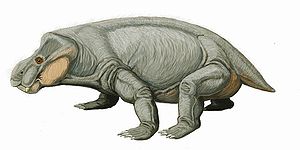Kannemeyeriidae
| Kannemeyeriidae | ||||||||||||
|---|---|---|---|---|---|---|---|---|---|---|---|---|

Kannemeyeria |
||||||||||||
| Temporal occurrence | ||||||||||||
| Anisium ( Middle Triassic ) to Norium ( Upper Triassic ) | ||||||||||||
| 245.9 to 199.6 million years | ||||||||||||
| Locations | ||||||||||||
|
||||||||||||
| Systematics | ||||||||||||
|
||||||||||||
| Scientific name | ||||||||||||
| Kannemeyeriidae | ||||||||||||
| Huene , 1948 |
The Kannemeyeriidae are extinct land vertebrates from the group of therapsids ("mammal-like reptiles"). They lived during the Middle and Upper Triassic . The group's fossils have been found in Africa, North and South America, Europe, India, and China.
features
They had a barrel-shaped trunk and a short-snouted skull, similar to that of Lystrosaurus , on which, in contrast to this, was a narrow intertemporal ridge. The skulls reached lengths of 25 to 60 centimeters. The postcranial skeleton (the area of the skeleton following the skull) resembled that of the Permian dicynodontia , but was even more compact, the legs more stocky. The pelvis has a conspicuous anterior outgrowth of the ilium and a reduced pubis , which probably opened up the possibility that the animals could stand up on their hind legs to eat leaves from higher plant sections.
Systematics
-
Kannemeyeriidae Huene 1948
- Angonisaurus Cox 1983
- Barysoma Cox 1965
- Chanaria Cox 1968
- Dinodontosaurus Romer 1943
- Dolichuranus Keyser 1973
- Elephantosaurus Vyushkov 1969
- Jacheleria Bonaparte 1971
- Kannemeyeria Seeley 1908
- Parakannemeyeria Sun 1960
- Placerias Lucas 1904
- Rabidosaurus Kalandadze 1970
- Rechnisaurus Roychowdhury 1970
- Rhinocerocephalus Vjuschkov 1969
- Rhinodicynodon Kalandadze 1970
- Sangusaurus Cox 1969
- Shansiodon Yeh 1959
- Sinokannemeyeria Young 1937
- Tetragonias Cruickshank 1967
- Uralokannemeyeria Danilov 1971
- Vinceria Bonaparte 1969
- Wadiasaurus Roychodhury 1970
- Zambiasaurus Cox 1969
literature
- Thomas S. Kemp: The Origin & Evolution of Mammals. Oxford University Press, Oxford 2005. ISBN 0198507615 .
Web links
- The Paleobiology Database Kannemeyeriidae
- Palæos Kannemeyeriidae

